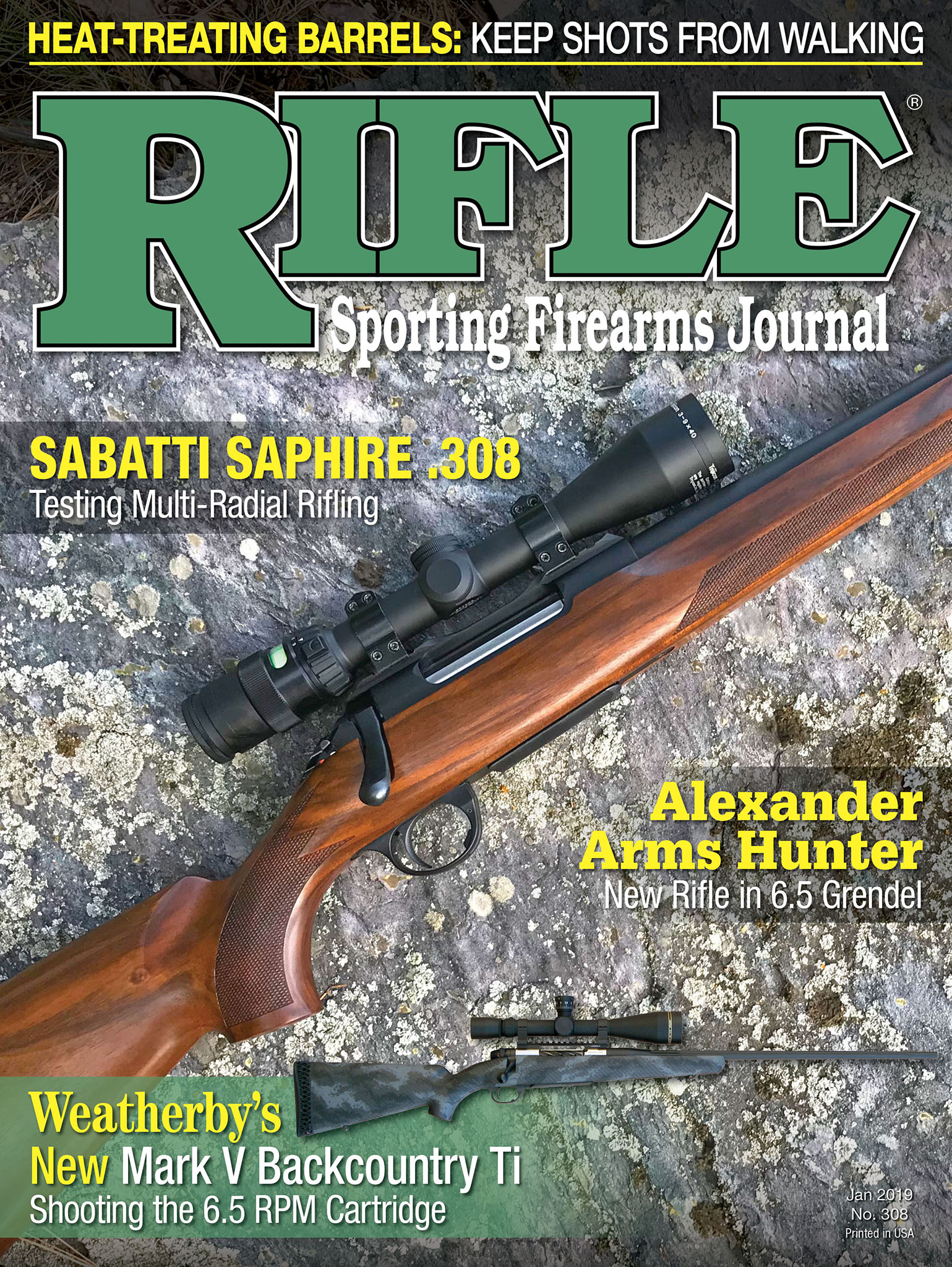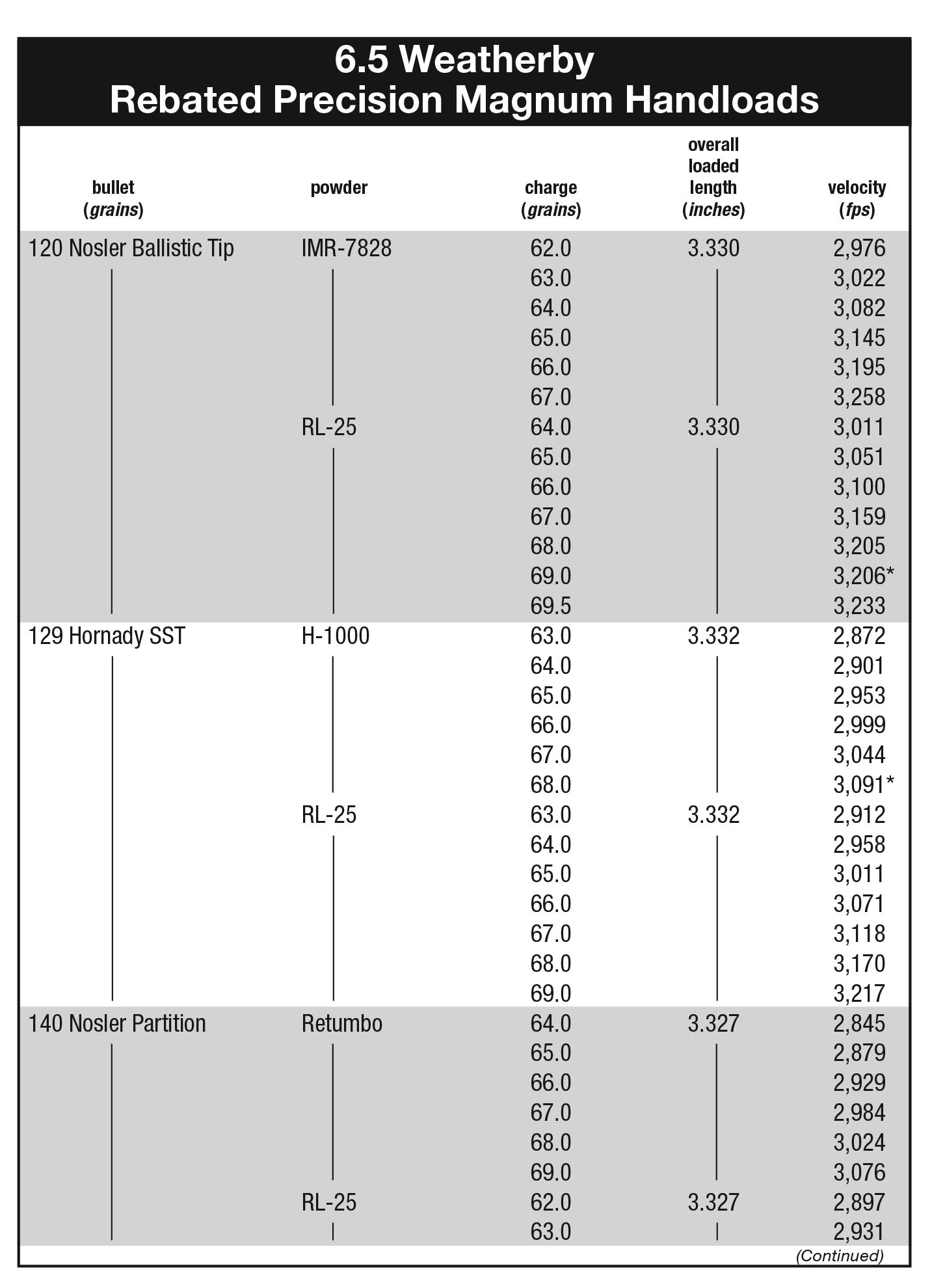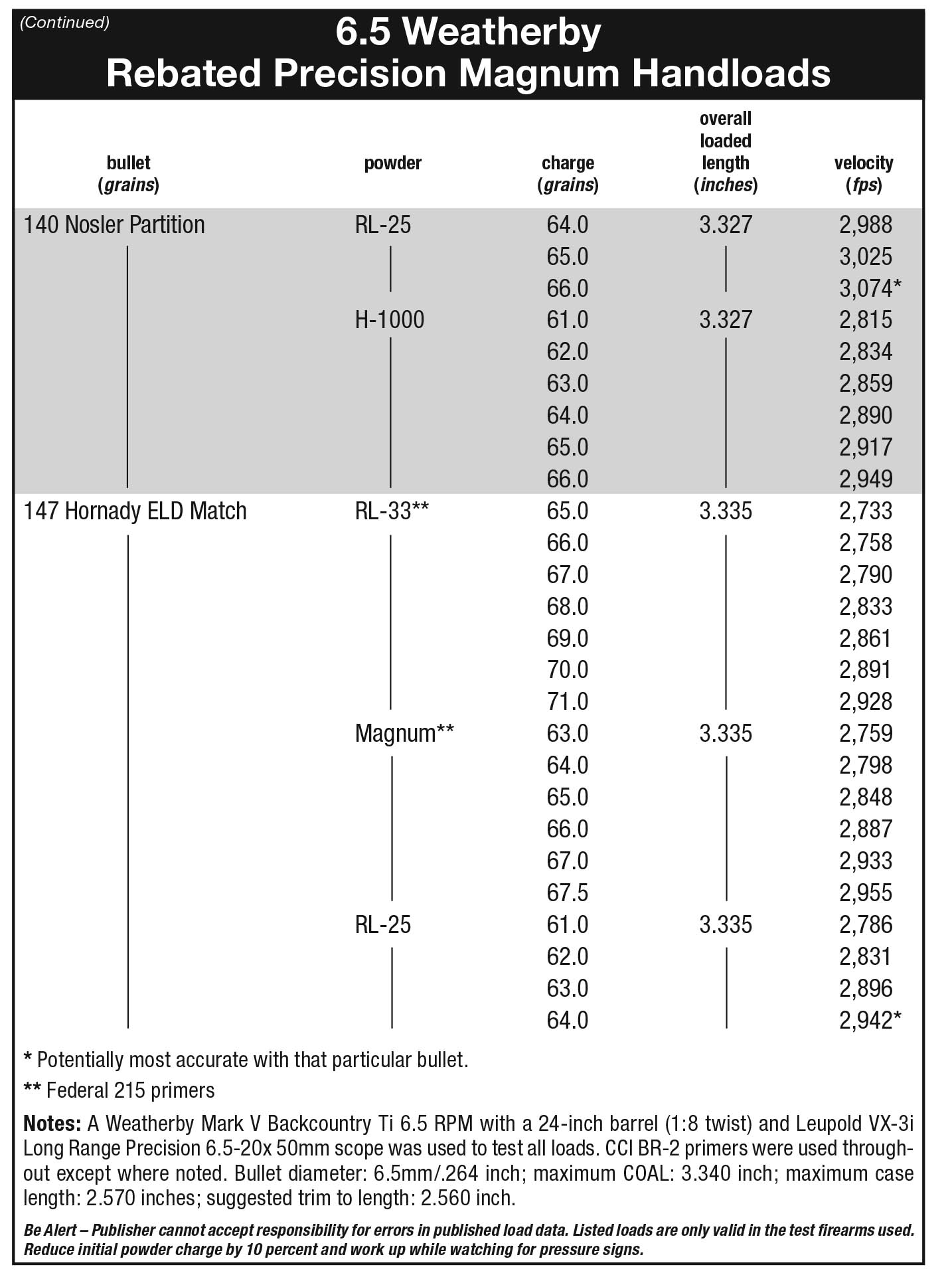Weatherby's New Mark V Backcountry Ti
Shooting the 6.5 RPM Cartridge
feature By: Brian Pearce | March, 20


During World War II, Roy Weatherby (1910-1988) began experimenting with wildcat cartridges in an effort to reach greater velocities than provided by ordinary sporting cartridges. Most of his cartridges were based on the .300/.375 H&H Magnum belted case and necked accordingly. Each featured a rather unique double-radius shoulder design that is controversial; however, all cartridges offered significant powder capacity and reached new levels of velocity.

Early manufacture was in California, but production was soon moved to West Germany, with J.P. Sauer & Sohn producing rifles from 1959 through 1971, with some being imported as late as 1973. From 1971 through 1995, Howa Machinery in Japan produced the Mark V.
Beginning in 1995, production was moved to the state of Maine. However, soon after moving headquarters from Atascadero to Paso Robles, California, Mark V production was moved back to that state. As indicated, today the Mark V is produced in Wyoming. While Weatherby collectors love early Mark V rifles, the fact is that with each of the above production moves, the rifles were improved in design and quality, making them more reliable and accurate.

Roy Weatherby preferred what he referred to as a “handsome” and “nice rifle,” and this was the foundation of his business and was appealing to many hunters, shooters and collectors. By his definition, this translated into a rifle with a wood stock, preferably with beautiful grain and high luster finish, cut checkering patterns, contrasting forend caps and pistol grips (usually from rosewood), white line spacers, high polish blue finish, etc. For anyone wanting a true custom rifle, the Weatherby Custom Shop could accommodate any practical feature from highly figured walnut with ivory inlays to engraving with silver, gold and even diamond inlays. As Roy’s son Ed Weatherby joined the business, he brought new ideas, including rifles with a synthetic stock. Roy opposed the idea, as he considered them homely and felt that their customer base would much rather have a “nice rifle.” However, Ed moved forward with his ideas, and the Mark V Fibermark appeared in 1983 and became an instant success. In the decades since, the product line has been expanded extensively to include many synthetic stock variants, stainless steel, etc., that serve to satisfy today’s hunters and rifleman.
This brings us to the new Mark V Backcountry Ti that features a six-lug action with a notably smaller receiver ring than the traditional nine-lug Mark V. For comparison, the six-lug receiver ring measures 1.149 inches in diameter while most nine-lug versions measure around 1.330 inches. The six-lug action also features a notably smaller bolt body while the countersunk bolt face is suitable for cartridges featuring a rim diameter of .473 inch, such as the .30-06 and others, but it cannot accommodate cartridges on the larger belted magnum case. The bolt lift remains 54 degrees.


While titanium has a reputation of being difficult to machine, modern techniques and tooling allow much more precise cuts and minimize galling and high parts rejection. To help prevent coining, a condition wherein titanium peens from head thrust and high pressure and can cause headspace to become excessive, the bolt assembly and locking lugs are constructed of high tensile chrome-moly steel that is CERAKOTE finished.
The Backcountry stock profile is a distinct departure from traditional Weatherby configuration. For example, from the very beginning Weatherby rifles have been primarily fitted with Monte Carlo style stocks, although there have been a few variants fitted with traditional classic style stocks. The Backcountry stock is a classic design without a cheekpiece. However, like so many modern hunting rifles designed to be fired from a variety of positions, including prone, the stock features a slightly negative comb, and rather than a Weatherby pattern square forend tip, it is rounded. My only real criticism of the stock includes the 3D Hex recoil pad that seems overly hard; however, since the recoil of the 6.5 Weatherby RPM is modest, this is something of a moot point. Overall, the stock is trim, lightweight, comfortable and features a 135⁄8-inch length of pull.

Several years ago, while hunting with Adam Weatherby and another employee, I suggested they develop a new 6.5 cartridge. We discussed my ideas, including ballistics and if the new cartridge should fit a short action length (2.810 inches), standard length (3.340 inches) or the long action (3.600 inches). I could tell by the conversation that they were holding their cards closely, so to speak. Soon thereafter, the fast 6.5-300 Weatherby Magnum was introduced and is advertised to push a Barnes 127-grain LRX at 3,531 fps, a Swift 130-grain Scirocco at 3,476 fps and a Swift 140-grain A-Frame at 3,395 fps. While this cartridge has been popular, it provided greater velocity, powder capacity and barrel wear than I wanted.

This brings us to the 6.5 Weatherby RPM advertised to push a Barnes 127-grain LRX bullet at 3,225 fps or a Nosler 140-grain AccuBond at 3,075 fps, which delivers all of the ballistic performance I originally had in mind. It is based on the 6.5-284 Norma case, but stretched with a case length of 2.570 inches and an overall cartridge length of 3.340 inches (the same as the 30-06). While the 6.5-284 Norma has a 35-degree shoulder angle, the 6.5 Weatherby RPM shoulder is 35.25 degrees. Water capacity measures 81.5 grains, which was checked by using a once-fired, full-length sized case with water filled level with the case mouth.

Back in the day, I became fond of the performance of the .264 Winchester Magnum, but it had certain shortcomings. If memory serves correctly, it was originally advertised to push a 100-grain bullet at 3,700 fps and a 140 grain at 3,200 fps, but real velocities from a 26-inch barrel were notably less. Today it is advertised to push a 140-grain bullet at 3,030 fps. The 6.5 RPM exceeds .264 ballistics while producing lower extreme spreads, greater accuracy, efficiency and longer barrel life. Due to its .473-inch rebated rim, it can be housed in the trim Weatherby Mark V six-lug action.

While the 6.5 RPM will not outrun the .26 Nosler or 6.5-300 Weatherby Magnum, it will easily exceed the ballistics of the 6.5 Creedmoor, .260 Remington, 6.5-284 Norma and even the relatively new 6.5 PRC. It offers an excellent blend of velocity, moderate recoil and respectable barrel life.
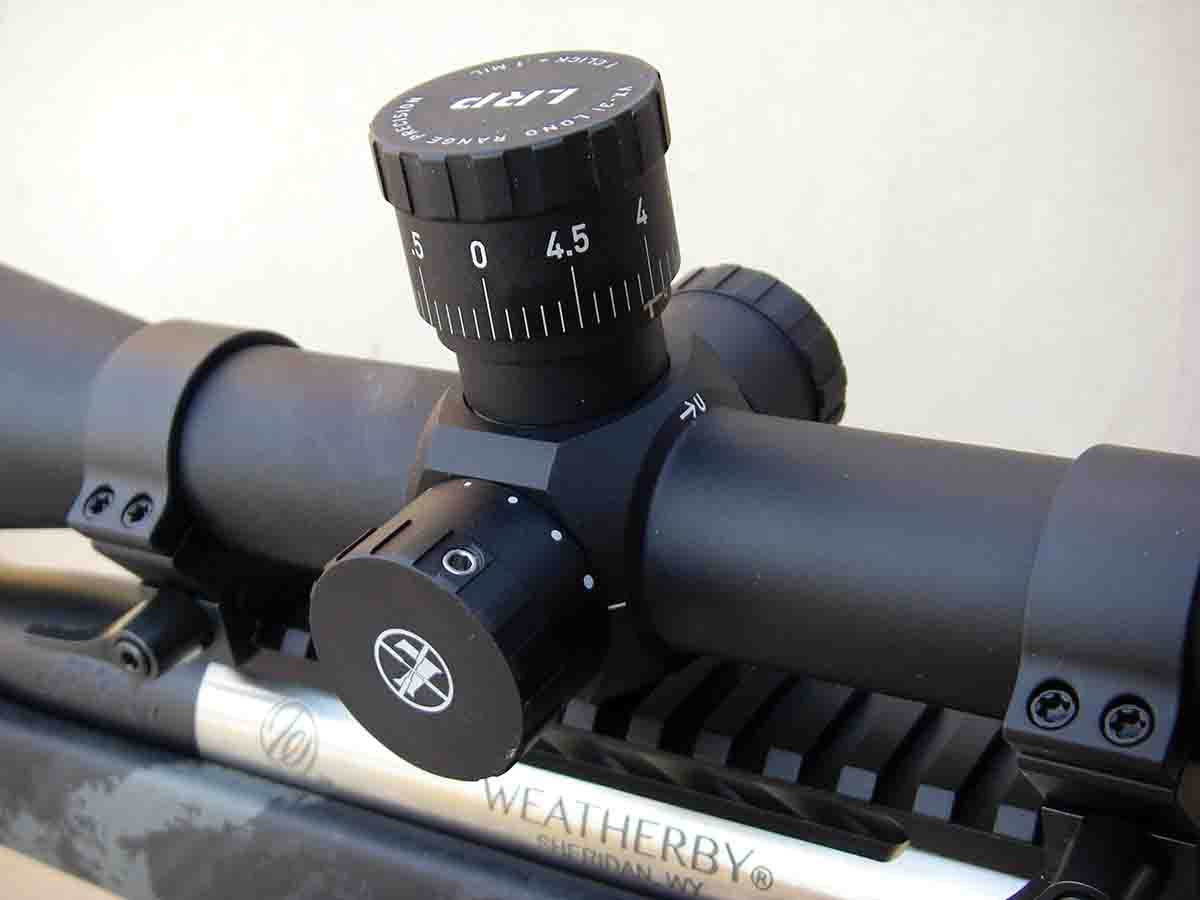
To test the Mark V Backcountry Ti, a Leupold VX-3i Long Range Precision 6.5-20x 50mm scope was installed and features a first focal plane TMR reticle. This scope offers features sought after by modern hunters, including argon/krypton waterproofing. It’s shockproof, features blackened lens edges, DiamondCoat 2 exterior lens coatings, click adjustments, side focus (side parallax adjustment), a tactical power selector and other enhancements. Due to its Twilight Max light management system, it offers outstanding resolution and definition. As this is written in the middle of hunting season, there are literally no “low” rings available in any of the stores in my region, so “medium” Leupold QRW rings were used. While they worked fine, lower rings would have provided a better cheek weld. Even with a rather large 30mm main tube scope with a 6-20x variable along with steel rings, the total weight of the rifle was less than 7 pounds.
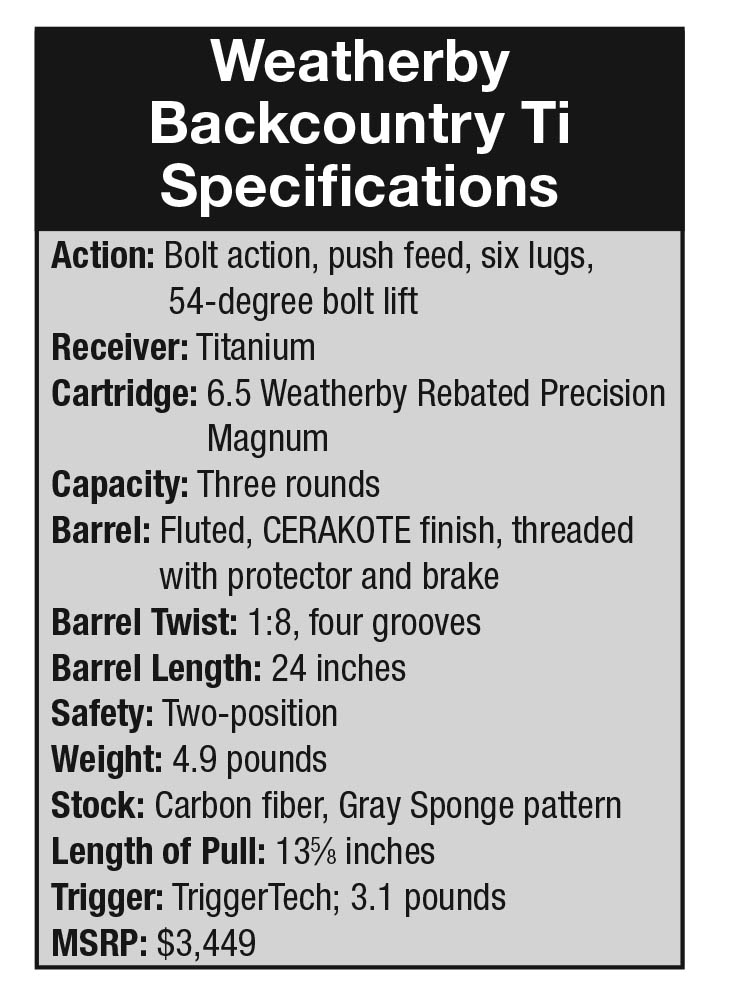
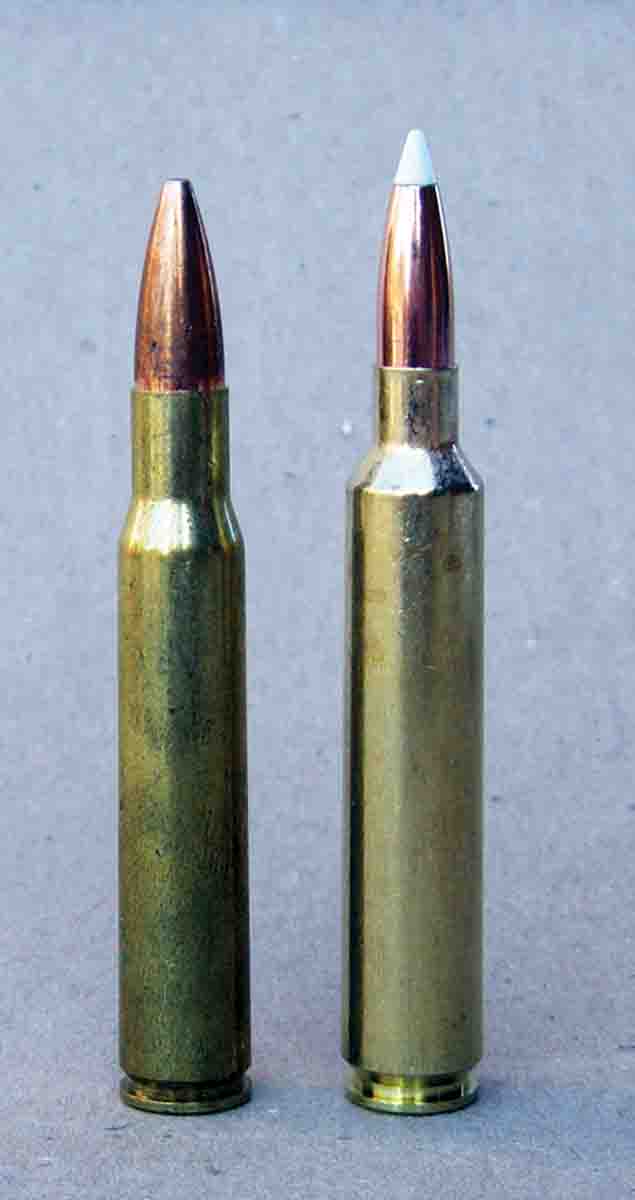
Next, the barrel was cleaned and development of handload data began. At the time of this writing there is no lab tested data available. However, I was able to calculate beginning charge weights, which were then checked for pressure and performance, and charges were increased to near maximum. Ultimately, I was able to more or less duplicate 140-grain factory load performance using Nosler 140-grain Partition bullets pushed with Hodgdon H-1000, Retumbo and Alliant Reloder 25 powders. Using the two latter powders I was able to exceed factory load velocities by more than 100 fps. As can be seen in the accompanying table, additional bullet weights and powders were selected, including Hornady’s 129-grain SST pushed to over 3,200 fps with 69 grains of Reloder 25 powder. Switching to the 147-grain ELD Match bullet, Alliant Reloder 33, Reloder 25 and Ramshot Magnum each reached around 2,950 fps. This bullet features a high G1 ballistic coefficient of .697 and is certain to prove an excellent long range option. Most of the handloads proved capable of sub-MOA accuracy.
It should be noted that most handloads were developed with a CCI BR-2 Large Rifle primer, which produced adequate ignition with most loads. The exceptions were loads containing Reloder 33 and Ramshot Magnum powders, which were capped with a Federal 215 Large Rifle Magnum primer.
The Mark V six-lug action is designed to accommodate cartridge lengths up to 3.340 inches, so to maintain reliability in the magazine, overall loaded cartridge lengths had to be kept within that figure. Experiments were conducted with bullets seated out (when compared to listed lengths) to possibly improve accuracy. While there were accuracy increases, they were not significant.
Weatherby has developed a rifle and cartridge that are modern and are certain to be anxiously accepted by shooters and hunters.


